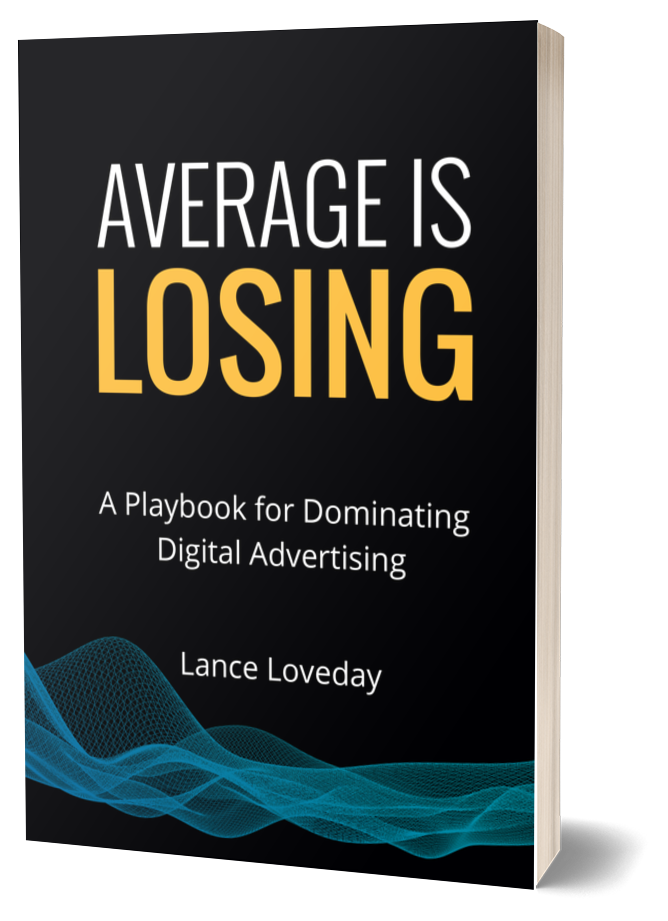Consumers expect personalization and privacy, but can they have both?
As a recent speaker at SMX Advanced, I explored the possibilities, given the complexity of tracking and targeting changes shaking up our industry.
The recent iOS 14.5 rollout that prompts users to decide whether or not they want to be tracked by their mobile apps has decreased conversion data visibility. And by the end of 2023, Google Chrome will join the squad of cookie-blocking browsers.
Today’s current pressure to move away from cookies shouldn’t be a surprise. Cookies have always been far from perfect. Poor match rates, cross-device complexities, ad blockers and attribution issues are problematic, often making third-party data unreliable.
The advertising industry, which has relied heavily on cookies for tracking success metrics and audience targeting, needs to find new measurement methods and relearn how to serve relevant messaging to the right people.
Rather than recognizing devices, advertisers must return to a people-based marketing mindset—building individual profiles with offline and online data to accurately recognize and reach customers on any device.
Using a cross-device, customer-centric and holistic approach creates a personalized, relevant experience for users. In return, brands shorten sales cycles and preserve budgets. To achieve this, customer data must be integrated with ad platforms and deliver the right experience to the right person at the right time.
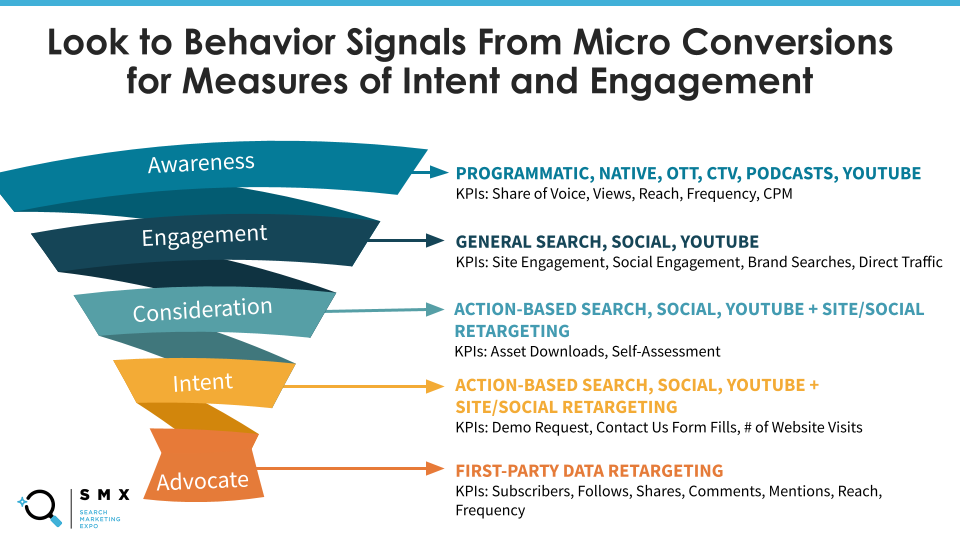
Third-party data or demographic/interest information gathered by an intermediary like an ad platform is wavering, and first-party data needs to replace it. First-party data is the most valuable data advertisers have at their disposal because the information comes directly from website visitors, leads and customers. The more first-party data collected, the better advertisers can understand and personalize the customer journey.
Gathering ample data can stitch together a full story on your audiences’ interactions. Beyond form fills and purchases, intent signals at each funnel stage clarify where users are in the funnel so you can serve them the right content at the right time.
The actions a user takes should correspond to a place in the marketing funnel, and they should be served relevant content accordingly. Set up events as conversions in the ad platforms and optimize them at the appropriate stages. Micro conversions explain where a customer is in their journey and help provide a more personalized advertising experience.
In addition to tracking front-end performance metrics ad platforms provide, blend your backend or CRM data with this information. Adding UTMs for keyword ID and creative ID can explain where revenue comes from right down to the keyword and ad level.
Dynamic UTM parameters automatically capture and accurately update data with each ad click. Hidden fields need to be added to your web forms to get this information to pull through to CRM and backend reporting. Understanding which keywords and ads an opportunity converted on provides insights on what’s working vs. what’s not, allowing for more intelligent optimizations.
While Closed Loop leverages Tableau for data visualizations and analysis, it’s possible to create simple pivot tables in a spreadsheet to analyze spend and performance by keyword, landing page, ad, device and more. Seeing where down-funnel conversions are coming from helps us recommend a proper budget mix and spend the most valuable dollars first.
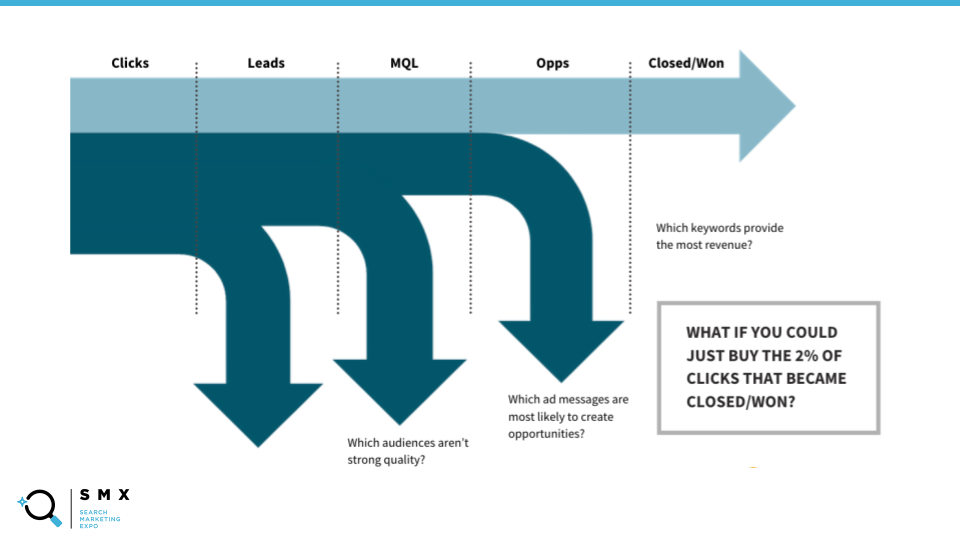
With better tracking in place, there’s more opportunity to focus on reaching your target audience. Advertisers have historically relied on third-party data for interest and demographic-based targeting. With cookie changes coming down the pike, we must rethink our targeting strategy to create a more personalized, relevant experience for the end user. Leveraging first-party data for strong cross-channel retargeting and building lookalike audiences is the best way to replace third-party cookies.
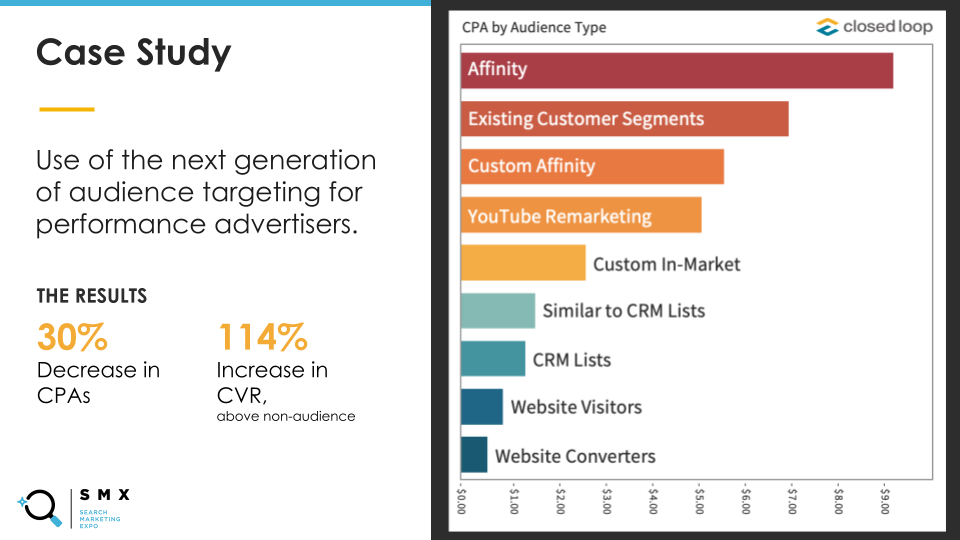
A Closed Loop case study shows we often see lower cost per leads for these first-party audiences anyway. By leaning into our CRM lists and website retargeting, we reduced cost per lead by 30%. Conversion rates also improved 114%, proving this strategy is more cost-effective than third-party audiences.
Targeting via first-party data is easier than you might think. There are marketing automation integrations between CRMs and ad platforms that allow for easy targeting of high-value lists. From there, advertisers can build similar or lookalike audiences off of those lists to leverage the ad platforms’ machine learning capabilities. These integrations improve lead quality, serve ads to key audiences and provide a more relevant ad experience for the user, without relying on cookies.
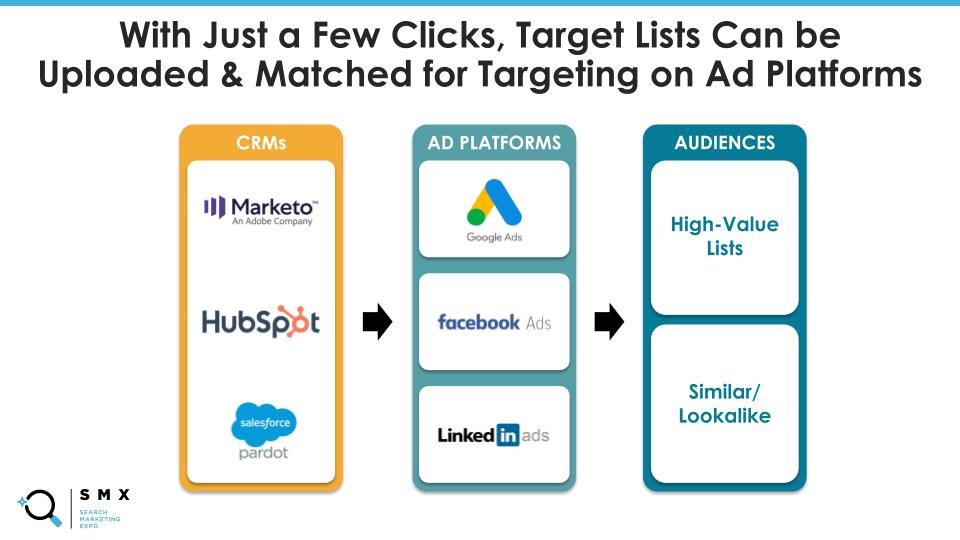
We can ensure users are seeing the right message based on what CRM list they belong to. This means you can change the messaging you serve a user based on where they are in the funnel. If they were once a part of a top of funnel list where they were served a brand video for awareness, but now they take action and move down the funnel, you can use automation to update which list the user belongs to and serve them mid-funnel content to keep up with their journey.
Another strong tactic is creating target lists based on lead scoring. If a user takes action with another sales or marketing program and their lead score changes, automation can update the list they belong to and serve them appropriate content as they flow down the funnel. Since the list segments are so easy to update, audiences won’t see irrelevant messaging just because you haven’t updated the list in a while.
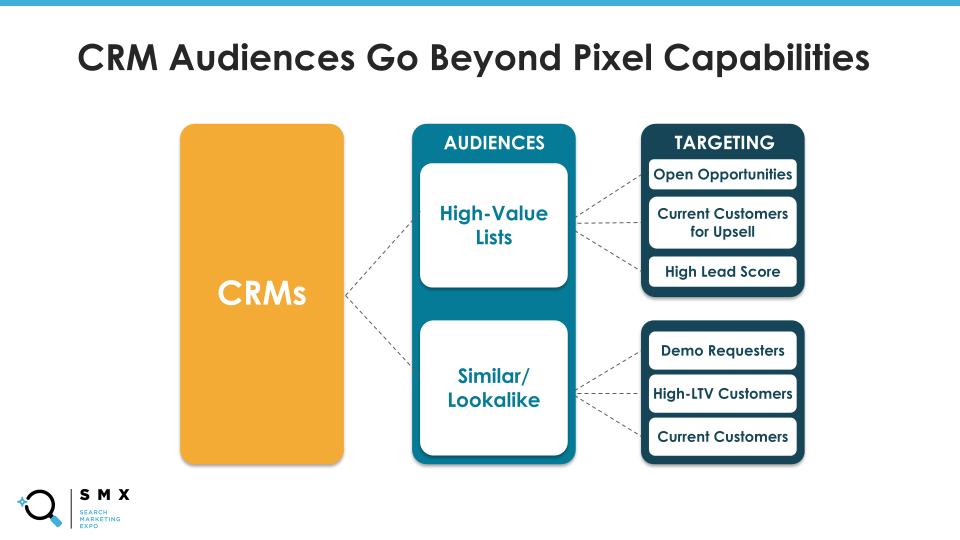
By leaning on your CRM data, you can go beyond what cookies are capable of. You can tap into new and existing audiences to serve them relevant content and nurture them to be ready to make a decision.
This is great for nurturing open opportunities, retargeting accounts with high lead scores that haven’t converted yet and upselling current customers––not to mention retention efforts around renewal time to decrease churn rates. We can also use machine learning to find audiences that look like your highest lifetime value customers and those that partake in the down-funnel activity. This opens doors for you to expand your reach and find users most likely to be interested in your brand.
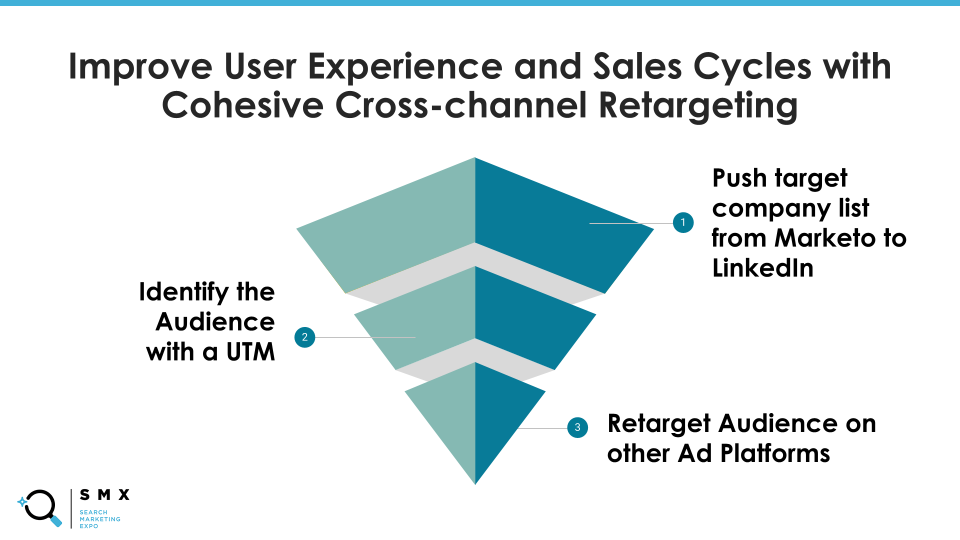
Website retargeting has always been a lucrative targeting tactic but it will become more important as our need to rely on first-party data increases. Whether you are serving ads to a CRM list or another in-platform audience, you can add a UTM to the ad URL that identifies your audience and from there, retarget that UTM across other platforms.
For example, LinkedIn has strong job title targeting capabilities. If you are targeting a group of C-suites, you can add “utm_term=c-suite” to the ad link. Now, build an audience for the Google Display Networking based on website visitors whose URL contains “utm_term=c-suite”. This way, you can continue to serve this audience with relevant content across the web, improving the user experience and offering consistent, streamlined brand messaging.
Now, to take those audiences and make the most of them, we can leverage APIs like Google’s Offline Conversion Tracking or Facebook’s Conversions API to help us uncover key performance metrics. This technology tells our front-end and back-end systems to communicate, optimizing for better quality audiences and improved return on investment.
Machine learning capabilities will also help us to improve efficiency and scale campaigns. This integration is the future of advertising analysis and optimization as our platforms begin to rely more on machine learning and automation throughout the journey as the shift away from tracking continues.
After a user submits a website form, their ad click gets assigned a unique identifier which gets assigned to their record in your CRM after they fill out a website form. The CRM then syncs back to the ad platform to tell Google if and when a conversion moves down the funnel. Passing the data back and forth can help both you and the ad platform algorithms better understand what is driving action so you can make decisions to further improve results.
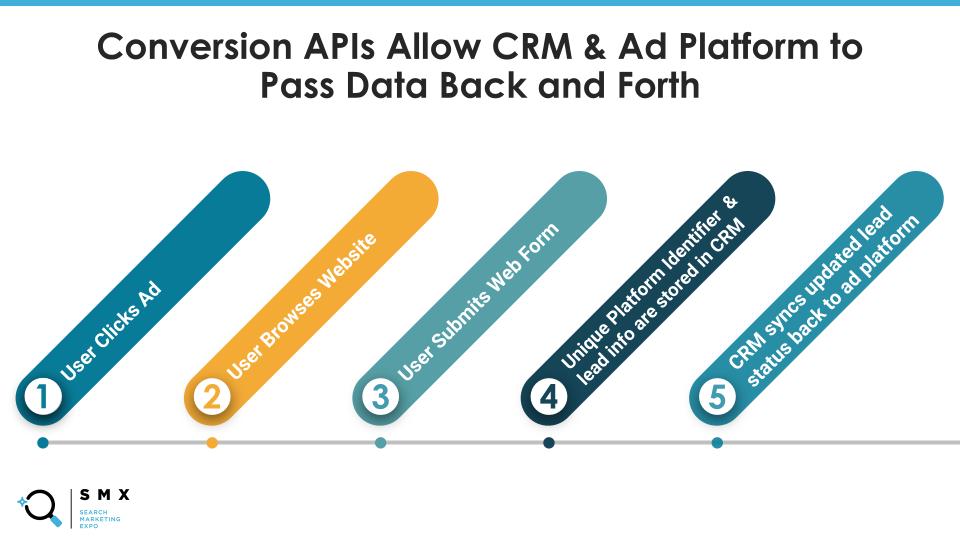
For example, after the integration is set up, custom columns can be added to the platform interface to see where sales accepted leads are coming from. Adding this custom column allows for insights at the ad group, keyword, ad, landing page level and beyond to help make those tweaks wherever needed. This offers you a visual way to adjust your bids and allocate budgets to those top-performers.
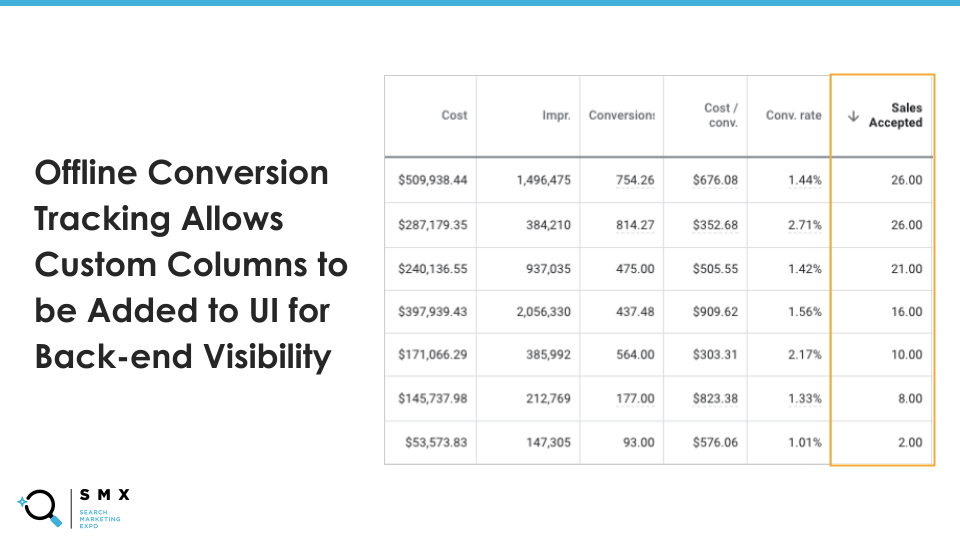
While conversion APIs have been around for several years now, it can still be labor-intensive to get set up. However, you can use Zapier for an easier connection which can save time. From here, you will want to tell the algorithm the value of each of your conversions. By assigning different values or weights to a newsletter sign-up vs. an ebook download vs. a demo request, you can train the algorithm to seek more lower-funnel conversions, unlocking smart bidding. Smart bidding strategies like Target ROAS trains the algorithm to focus on actions that will most likely generate revenue and find higher-value targets.
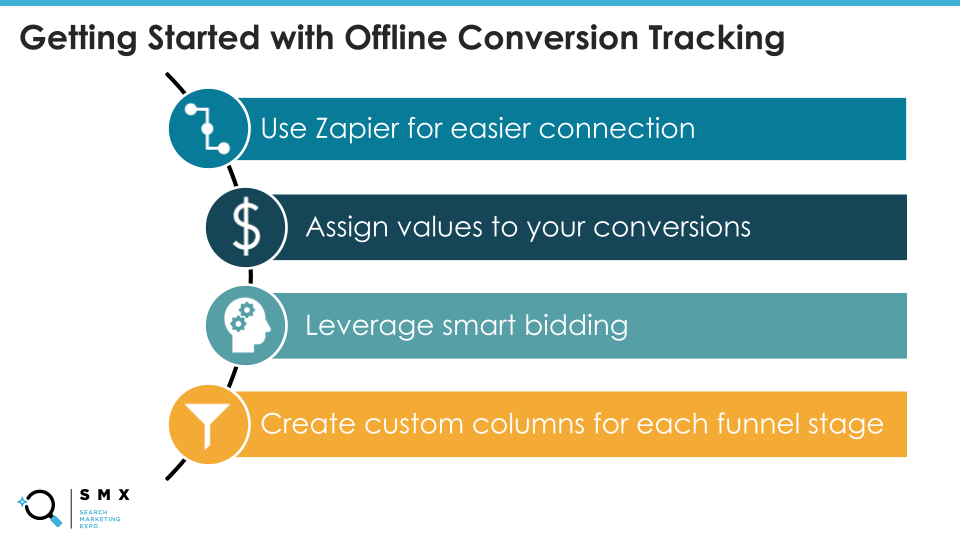
While the API connect sounds more effective than the UTM blending method I mentioned earlier, each one has its pros and cons.
The manual UTM blending is the easiest to do and is available on all platforms, but the downside is that data is not shared back to the platforms so it can’t be used for machine learning optimizations or targeting.
Next, we have the manual upload. Once you have the unique click identifiers (like GCLID) tracking in your CRM, you would then manually upload your back-end report to the ad platform. Unfortunately, this is a manual process and therefore cannot be used in machine learning-–unless you’re taking the time to do this each day.
The optimal solution for connecting your data to our ad platforms is connecting through an API. This is ideal for targeting and tracking as it allows your back-end systems to sync in real-time with the ad platforms. But it’s not available across all advertising platforms and unfortunately, GCLIDs are only held by Google for 90 days. So if you have longer sales cycles, you will be missing out on insights.
With iOS 14.5 in play, GCLIDS will not be captured by mobile apps if the user did not consent to be tracked. Adding UTMs to the ad URL will allow you to gain visibility on the backend of where this conversion came from. So ideally, you should use a combination of the manual UTM blending and the API connect to improve your performance data.
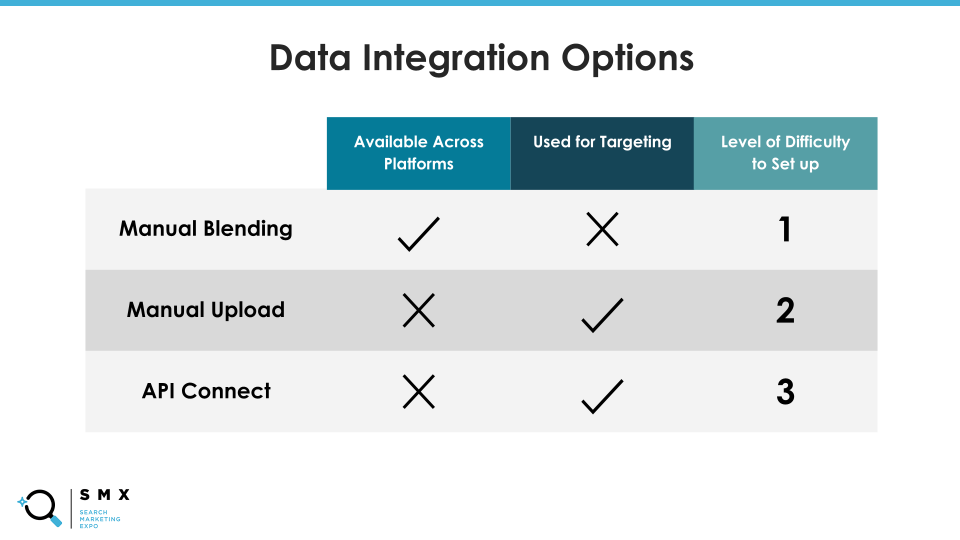
In conclusion, our industry is being disrupted and we need to adapt or die. It is crucial that we do more with the data we already have to analyze where we are getting the most value.
It is also imperative to structure our campaigns around those insights to ensure budget flows to the most valuable areas first and from there, we can scale those top performers to continue feeding the funnel and start it all over again!
Think about how much of your media currently rely on third-party cookies, consider replacing it and up your first-party game. If you’re not making the most of your first-party data, you’re at risk of falling behind your competitors. Get a leg up now before it’s too late.
In the infamous words of Ricky Bobby from Talladega Nights, “If you ain’t first, you’re last.”
My new book, “Average is Losing” is finally here! I created this playbook to help savvy advertisers close the gap between winning and run-of-the-mill paid advertising campaigns.
It’s filled to the brim with the latest strategies, tactics and tips our Closed Loop experts use to help our clients seek exponential growth.
Are you ready to rise above average campaign performance? Start your business on the path to PPC domination today!
– Lance Loveday
